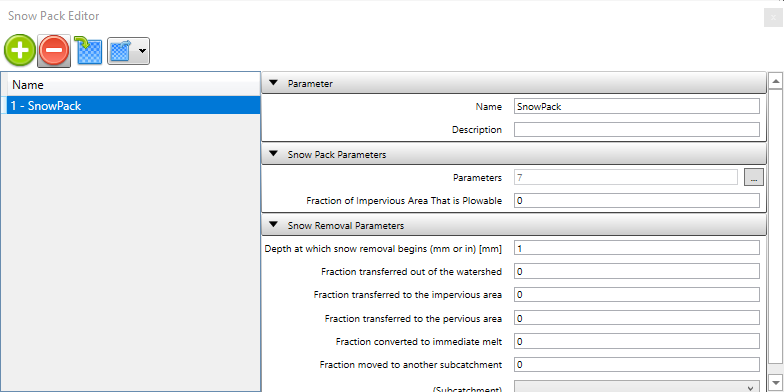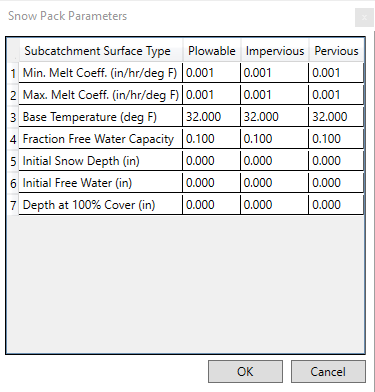The Snow Removal page in the Snow Pack Editor dialog explains how snow removal works within the plowable area of a snow pack. Several parameters control this process:
Click the Snow Packs button to open the Snow Pack Editor window.
| Button | Description |
|---|---|
 |
Add one snow pack |
 |
Delete selected snow pack. Please note to use Ctrl and Shift keys for multiple selection. |
 |
Import a group of snow packs |
 |
Export all the snow packs |

- Depth at which snow removal begins (in or mm): This is the depth that must be reached before any snow removal starts.
- Fraction transferred out of the watershed: The portion of snow depth that is removed from the system and doesn’t become runoff.
- Fraction transferred to the impervious area: The proportion of snow depth added to snow accumulation on the pack’s impervious area.
- Fraction transferred to the pervious area: The fraction of snow depth added to snow accumulation on the pack’s pervious area.
- Fraction converted to immediate melt: The portion of snow depth that turns into liquid water and flows into any associated subcatchment.
- Fraction moved to another subcatchment: The share of snow depth added to the snow accumulation on a different subcatchment. You must specify the subcatchment’s name.
It’s important to note that the removal fractions must add up to 1.0 or less. If less than 1.0, some fraction of snow depth will remain on the surface after all the redistribution options are considered.
Snow Pack Parameters can be open by clicking the button 

The Parameters page in the Snow Pack Editor dialog is where you set snow melt parameters and initial conditions for different types of areas: plowable impervious, non-plowable impervious, and pervious areas. This page has a data grid with rows for each parameter and columns for each area type:
- Minimum Melt Coefficient: The degree-day snow melt coefficient on December 21, measured in in/hr-deg F or mm/hr-deg C.
- Maximum Melt Coefficient: The degree-day snow melt coefficient on June 21, also in in/hr-deg F or mm/hr-deg C.
- Base Temperature: The temperature at which snow begins to melt (degrees F or C).
- Fraction Free Water Capacity: The volume of pore space in the snowpack that must fill with melted snow before liquid runoff starts, expressed as a fraction of snow pack depth.
- Initial Snow Depth: The depth of snow at the simulation’s start (in inches or millimeters).
- Initial Free Water: The depth of melted water within the pack at the simulation’s start (inches or mm), limited to the product of initial snow depth and the fraction free water capacity.
- Depth at 100% Cover: The depth of snow beyond which the area remains completely covered, not subject to any depletion effect (inches or mm).
- Fraction of Impervious Area That is Plowable: The fraction of impervious area that can be plowed and isn’t subject to areal depletion.


